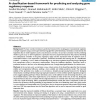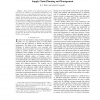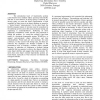954 search results - page 140 / 191 » Principles and Models for Organizing the IT Function |
BMCBI
2006
13 years 7 months ago
2006
Background: We have recently introduced a predictive framework for studying gene transcriptional regulation in simpler organisms using a novel supervised learning algorithm called...
BMCBI
2006
13 years 7 months ago
2006
Background: Modeling of cis-elements or regulatory motifs in promoter (upstream) regions of genes is a challenging computational problem. In this work, set of regulatory motifs si...
HICSS
2008
IEEE
14 years 2 months ago
2008
IEEE
: Cell phones are an emerging but rapidly growing area of computer forensics. While cell phones are becoming more like desktop computers functionally, their organization and operat...
CEC
2007
IEEE
14 years 2 months ago
2007
IEEE
— Many problems in the engineering domain involve more than one objective to be optimized simultaneously. The optimal solution to a multi-objective function results in a set of e...
HT
1998
ACM
13 years 12 months ago
1998
ACM
The presentation layer of hypermedia systems could benefit from standard object querying functionality and this is most effective if strong typing is enforced. By strong typing we...



